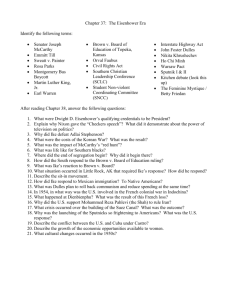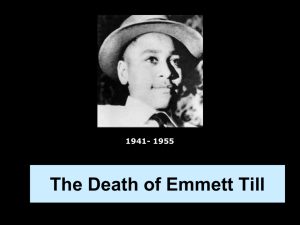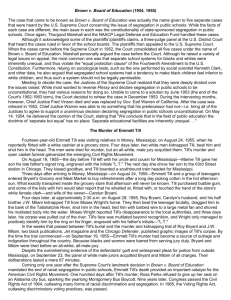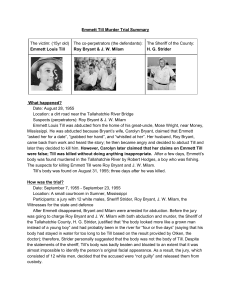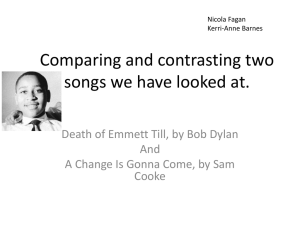Dwight D. Eisenhower
advertisement
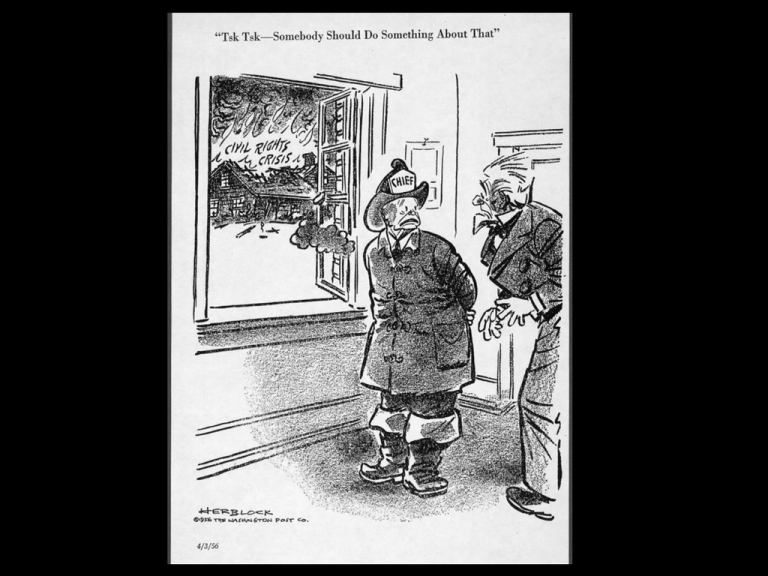
Dwight D. Eisenhower Domestic Policy and Civil Rights of the 1950s I. Election of 1952 (review) A. Democratic candidate: Adlai Stevenson B. Republican candidate: Dwight D. Eisenhower (VP) Richard M. Nixon C. Major issues: Korea, Communism, Corruption I. Ike and Modern Republicanism a. “Conservative when it comes to money; liberal when it comes to human beings” b. Ike cut billions of dollars from the federal budget by reducing the number of gov’t jobs and by leasing gov’t land c. Expanded Social Security and unemployment benefits; increased educational spending and minimum wage. II. The Affluent Society a. The 1950’s was a time of prosperity for many Americans; about 60% were earning a middle-class income b. Consumerism was highly promoted – “keeping up with the Joneses” c. Family life, accompanying the post-war “Baby Boom,” was promoted as well III. Election of 1956 - Candidates A. Democratic: Adlai Stevenson B. Republican: Dwight D. Eisenhower (Richard Nixon VP) C. Ike won just under 60% of the popular vote; electoral vote was 457 to 73 in favor of Ike! D. Ike failed to win either house of Congress for his party – country remained heavily Democratic – but everyone loved Ike. Electoral Map of 1956 IV. Major Legislation under Ike A. Federal Highway Act of 1956 (May) – authorized the construction of a network of superhighways; primary purpose was defense B. Civil Rights Act of 1957: 1. first civil rights bill passed in U.S. since Reconstruction!!! 2. Organized to investigate the abuses of “civil rights”: the rights of personal liberty guaranteed to United States citizens by the 13th and 14th amendments to the Constitution and by acts of Congress 3. Aimed to ensure that all African Americans could exercise their right to vote Beginning of the Civil Rights Movement (Ike’s 1st & 2nd Terms) I. Jim Crow in the South A. 1950: 15 million AfricanAmericans in the U.S. – 2/3 still lived in the South B. Only about 20% of Southern blacks were registered to vote C. Segregation legally upheld by 1896 Supreme Court Case Plessy v. Ferguson Remember, this established “separate but equal” D. Du jure vs. De facto segregation: du jure = segregation enforced by LAW De facto = segregation that exists in fact II. Brown v. Board of Education of Topeka, Kansas A. Earl Warren became the Chief Justice of the Supreme Court in 1953 B. May, 1954 - most important decision of the Warren Court C. In a unanimous decision, Brown v. Board overturned the Plessy v. Ferguson case by stating that segregation in public schools was “inherently unequal.” Chief Justice Earl Warren D. Brown decision declared that desegregation must go ahead with “all deliberate speed” E. Eisenhower was not a major force in desegregation; he said this case had upset “the customs and convictions of at least two generations of Americans.” III. Death of Emmett Till A. August 1955: 14-year-old Chicago boy visited relatives near Money, MS B. Supposedly whistled and called the wife of a local (white) store owner “Baby.” C. Till was taken a few nights later by the store owner and his brother-inlaw. D. Body of Till was found three days later in the Tallahatchie River – corpse unrecognizable E. Mother of Till insisted on an open casket funeral – so the entire world could see what happened F. Trial failed to convict the men accused of the crime – even with eye witnesses G. Huge impact on ALL AfricanAmericans – North/South From PBS’s timeline of the murder: September 21: Moses Wright, Emmett Till's great uncle, does the unthinkable, accusing 2 white men in open court. While on the witness stand, he stands up, points his finger at Milam and Bryant, and accuses them of coming to his house and kidnapping Emmett. September 23: Milam and Bryant are acquitted of murdering Emmett Till after the jury deliberates only 67 minutes. One juror tells a reporter that they wouldn't have taken so long if they hadn't stopped to drink pop. Roy Bryant and J. W. Milam stand before photographers, light up cigars and kiss their wives in celebration of the not guilty verdict. Moses Wright and another poor black Mississippian who testified, Willie Reed, leave Mississippi and are smuggled to Chicago. Once there, Reed collapses and suffers a nervous breakdown. http://www.pbs.org/wgbh/amex/till/timeline/timeline2.html 1956: January 24: Look magazine publishes an article written by Alabama journalist William Bradford Huie, entitled “The Shocking Story of Approved Killing in Mississippi.” Huie offered Roy Bryant and J. W. Milam $4,000 to tell how they killed Emmett Till. Milam speaks for the record. Bob Dylan “The Death of Emmett Till” IV. Montgomery, AL Bus Boycott A. Beginning: December 1955 B. Rosa Parks, a college-educated black seamstress, boarded a bus, refused to give up her seat on the bus to a white. C. She was arrested in violation of the city’s Jim Crow statues D. This action sparked a year-long bus boycott of the city’s buses. E. Reverend Martin Luther King, Jr. became the noted Civil Rights leader by organizing the bus boycott. F. King followed the principles of India’s Mahatma Gandhi – nonviolent resistance G. The boycott ended in Nov of ’56 when the Supreme Court declared AL’s bus segregation illegal. V. Little Rock Crisis A. South refused to abide by the Brown Decision B. Several “private” schools were created C. September 1957 – Orval Faubus, governor of Arkansas, mobilized the Arkansas National Guard to prevent 9 black students from enrolling in Little Rock’s Central HS A. Eisenhower was forced to send troops to escort the students to class. E. Little Rock High School closed in 1958 to avoid integration. VI. Southern Christian Leadership Conference (SCLC) A. Organized in 1957 by Martin Luther King, Jr. B. Churches were the largest and bestorganized black institutions allowed to be successful in the segregated society. C. This movement thus aimed to mobilize influential black churches on behalf of civil rights. Sit-In Movement • February 1, 1960: four African-American college students sat down at the lunch counter inside the Woolworth's department store in Greensboro, NC. The men ordered coffee, but following store policy, the lunch counter staff refused to serve them at the "whites only" counter; the store's manager asked them to leave. • The men stayed until closing, and they came back the next day... with friends (over 20 people). The continued to come until they received service. • The sit-in movement continued spreading, both at this store and around the state. - It took six months to accomplish its goal; in July of 1960, Woolworth's desegregated.
